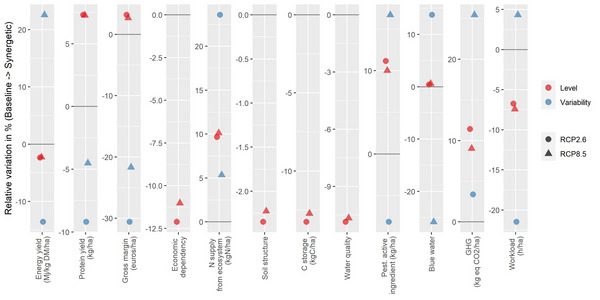In a first analysis, we used the modelling platform MAELIA to show that integrated crop-livestock systems, i.e. cooperations between crop and livestock farmers, at the regional level are a promising sustainable production model to address challenges of resource depletion and the negative impacts of agriculture, without harming farm economics (Catarino et al., 2021). The modelling platform MAELIA simulated outcomes emerging from interactions between stressors (e.g. temperature, rain) and management practices at the field and farm levels at daily intervals, over decades.
In a second study we used MAELIA to investigate the social, economic and environmental resilience to climatic shocks of different scenarios regarding the collaboration between seven neighbouring farms (five arable and two livestock) in Vendee, France (Case study 11, Co-design of diversified systems in Pays de Loire).
The resilience of the integrated crop-livestock system was investigated in the face of climatic perturbations represented by two climatic scenarios, RCP2.6 (global mean temperature increase below 2°C) and RCP8.5 (comparatively high greenhouse gas emissions; see links below for more information), for a period spanning from 2005 to 2050.
We compared resilience of two collaboration scenarios:
- The current baseline based on the world market: Livestock farms feed dairy cows with imported soja cakes.
- Full cooperation between farmers: arable farmers grow and provide pulses (pea and faba bean) to fulfil protein requirements of animal farms.
Resilience was evaluated through:
- 12 resilience-related performance attributes that need to be maintained to face hazards (table 1). They covered negative impacts, ecosystem services to farmers and society and economic performance and social acceptability.
- Four criteria to evaluate the dynamics of each performance attribute: the average level, trend, variability and resistance (see tables 2 and 3).
The results (Figure 1) at the territory level show that under both climatic scenarios, cooperation between crop and livestock farmers can bring an overall improvement to the economic, environmental and social resilience. Cooperation increased the annual mean gross margins by approximately 3% while decreasing the economic dependence on the market by 11%. It also improved ecosystem services for production (e.g. nitrogen supplied by the soil).
Diversifying the cropping system by introducing legumes has in parallel decreased variability of protein yield and economic dependency to external markets (due to fertilizer reduction and shift in animal feed diet).
However, the modelling results also bring to light negative aspects of diversification that must be considered before implementing this strategy in reality. For example, energy yield and carbon sequestration suffered a degradation due to the introduction of pulses in the rotation.
Our integrated assessment based on MAELIA is also useful to identify which farmers benefit, and why, as well as what interventions can support farmers who are negatively affected by climate shocks. Therefore, it can be concluded that MAELIA can be used to support policy makers and agricultural advisers in designing agricultural systems at the supra-farm level considering the trade-offs of a range of ecosystem services and socio-economic performances under different climate scenarios.
Further information
Table 1: Formulas and units for each performance attribute.
Table 2 and 3: Resilience framework (Table 2) and Criteria of dynamics and respective metrics (Table 3).
link.springer.com: RCP2.6: exploring the possibility to keep global mean temperature increase below 2°C
link.springer.com: RCP 8.5—A scenario of comparatively high greenhouse gas emissions
More information about future climate scenarios can be found at the IPCC website:
ipcc.ch: The Intergovernmental Panel on Climate Change
References
Catarino, R., Therond, O., Berthomier, J., Miara, M., Mérot, E., Misslin, R., Vanhove, P., Villerd, J., Angevin, F., 2021. Fostering local crop-livestock integration via legume exchanges using an innovative integrated assessment and modelling approach based on the MAELIA platform. Agric. Syst. 189, 103066. doi.org/10.1016/j.agsy.2021.103066
Dardonville, M., Bockstaller, C., Therond, O., 2021. Review of quantitative evaluations of the resilience, vulnerability, robustness and adaptive capacity of temperate agricultural systems. J. Clean. Prod. 286, 125456. doi.org/10.1016/j.jclepro.2020.125456
Johannes, A., Matter, A., Schulin, R., Weisskopf, P., Baveye, P.C., Boivin, P., 2017. Optimal organic carbon values for soil structure quality of arable soils. Does clay content matter? Geoderma 302, 14–21. https://doi.org/10.1016/j.geoderma.2017.04.021

 toccare e scorrere fino al comando Aggiungi alla schermata iniziale.
toccare e scorrere fino al comando Aggiungi alla schermata iniziale.